Scripps to Take Scientific Lead
in $25 Million Global Network to Monitor Greenhouse Gases
Ioana Patringenaru | Jan. 18, 2011
Videos

Watch a video about Scripps' collaboration with Earth Networks to build a $25 million global network to measure greenhouse gases in the atmosphere.
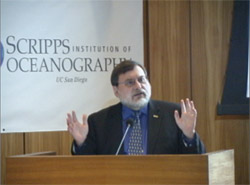
Tony Haymet, director of UCSD's Scripps Institution of Oceanography
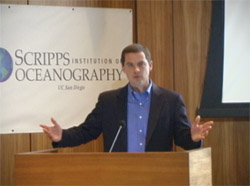
Bob Marshall, CEO of Earth Networks, talks about the new network and shows how the public could access the information it will provide.
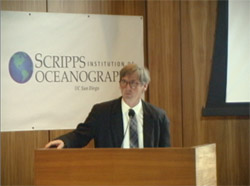
You wouldn’t go on a diet without weighing yourself. Likewise, you shouldn’t try to cut back on greenhouse gas emissions without finding an accurate way of measuring results. But that’s exactly what’s been happening, to a degree, in the United States and many parts of the world, scientists say.
Last week, UC San Diego’s Scripps Institution of Oceanography stepped in to become the world’s greenhouse gas scale, so to speak. Officials announced they had entered into a collaboration with Maryland-based Earth Networks, a company specializing in weather monitoring, that will provide $25 million over the next five years to create the largest privately funded global system ever built to monitor greenhouse gases, specifically carbon dioxide and methane.
The move comes at a time when some U.S. states have passed legislation to reduce carbon emissions and the European Union has instituted a complex emissions trading system for member countries.
The new network will allow Scripps scientists to produce emission measurements with increased precision. Data will be gathered at 100 stations around the world, including 50 in the United States. The goal is to measure emissions for countries, states and even counties—an unprecedented feat.
“With better measurements comes better science and with better science comes better decision making,” said Robert Marshall, Earth Networks’ CEO.
This new initiative hails back to greenhouse gas research started in 1958 by Charles Keeling at Scripps, resulting in the renowned Keeling Curve, Scripps Director Tony Haymet said Wednesday during a press conference here.
In this era of tight finances and budget cuts, it would have taken Scripps scientists a decade to raise money for the project from traditional funding sources, Haymet said later. He had been trying to find funds for the network for four years. The partnership with Earth Networks came together over the past year, as Scripps worked with the company on another project. “It’s an important day for us,” Haymet said.
Scripps’ role
Two Scripps scientists, Ray Weiss and Ralph Keeling, Charles Keeling’s son and a renowned greenhouse gas emissions specialist in his own right, will lead a climate research center named after the Maryland company.
“I’m a measurements guy, and that’s what they need: good measurements,” said Weiss, a research professor specializing in geochemistry. The partnership harnesses private funds to serve the public good, he said. Scripps’ cachet adds credibility to the enterprise, he added.
“I’m doing this because I think it’s important for society,” Weiss said.
Scripps scientists will make sure Earth Networks’ $25 million is well spent, said Keeling. They will shape the network’s infrastructure and characteristics, including where to locate stations and making sure data is useful and of high quality. The project will provide information that society badly needs, Keeling said.
The need for better measurements
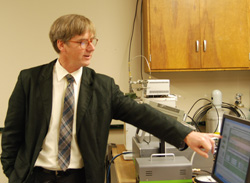
Scripps researcher
Ralph Keeling shows how measurements will be processed.
As nations are trying to reign in their greenhouse gas emissions, the way these emissions are measured and reported has come under scrutiny. Countries report their emissions based on how many vehicles are on the road; how much garbage in landfills; and how many cows in pastures. Companies usually report their emissions based on how many raw materials or hydrocarbons they’re using. But they’re not actually measuring the greenhouse gases they’re releasing into the atmosphere. Many scientists, including Weiss, have been advocating for actual atmospheric measurements, which this new network will provide.
When countries in the European union compared data reported through the usual method against atmospheric measurements, they found significant differences, Weiss said. When Germany recalculated its data, reported emissions increased by 40 percent.
The National Oceanic and Atmospheric Administration currently supervises 80 sites to measure greenhouse gas emissions in the atmosphere, said James Butler, director of Global Monitoring at NOAA’s Earth System Research Laboratory. But that only allows researchers to crank out numbers for entire continents, or very large regions. The additional stations funded by Earth Networks will allow for much more detailed analysis.
“We need to be better, we need to get a finer scale,” Butler said.
High precision is the landmark of the greenhouse gas measuring business, said Michael Woelk, president and CEO of PICARRO, the manufacturer that will provide the instruments placed on high towers that the network will use. CO2 represents a mere 0.039 percent of the Earth’s atmosphere. That’s akin to finding 66 people in all of China. Methane is even less, at 0.00019 percent—one person in all of China. Woelk’s company uses spectroscopy to detect the gases.
“We’ll be enabling people to measure the global carbon cycle at all scales,” he said.
Who will get the data
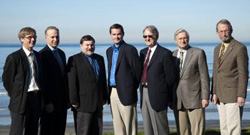
Officials pose for a group photo before Wednesday's press conference.
The measurements will be available for free to the academic community. Some data also will be available to the public at Earth Networks’ WeatherBug website. The company plans to use its expertise in weather modeling to show how greenhouse gases travel across regions throughout the day.
As more and more countries try to regulate greenhouse gas emissions and start trading carbon credits, the network will play a vital role in examining whether policies met their goals, said Marshall, the Earth Networks CEO. In 2006, California legislators passed AB 32, which aims to roll back greenhouse gas emissions in the state to 1990 levels by 2020. European Union leaders have made a commitment to bring emissions at least 20 percent below 1990 levels by 2020. On the East Coast, the Regional Greenhouse Gas Initiative requires power companies to pay for carbon dioxide emissions.
“We’re undertaking something that’s going to have a great impact on society,” Marshall said.
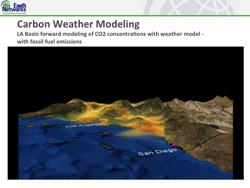

Left: A simulation shows how CO2 ebbs and flows during the day over Southern California.
Right: The new network will deploy 100 monitoring stations throughout the world.

|